-
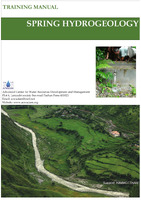 Spring Hydrogeology_ Training Manual
Spring Hydrogeology_ Training Manual Springs are a vital source of water supply to villages in the Himalaya, with about 60% of the population relying on natural spring water for drinking water, sanitation, and irrigation. With changing climatic conditions and rainfall patterns, many villages, hamlets, and settlements are facing potential drinking water shortages. Hydrogeological investigations are crucial to address this crisis and the impending peril. The revival of springs is essential for the region's sustainable growth. Over the last few years, many governmental and non-governmental organizations have initiated spring development programs in the Himalayan states. However, many of these programs fail due to lack of knowledge of the subsurface and lack of hydrogeological input in planning recharge measures. Springs are controlled by diverse geological features, which are not targeted by conventional watershed development projects. Recharge plans for springs must address quality issues, which cannot be done without understanding the geological influence on the water. The recharge area of a spring is decided after considering factors such as geology, permeability, weather, spring discharge measurement, and water quality monitoring.
-
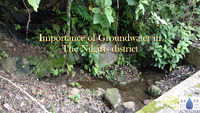 Importance of ground water in The Nilgiri district
Importance of ground water in The Nilgiri district Groundwater is a vital resource that feeds various sources, including aquifers and springs. Aquifers are rocks or rock material that allow groundwater to store and move within it, making it available to wells, springs, and bore wells. Springs are locations or points on the ground surface where water from beneath the ground emerges on to the surface. Spring depletion can be caused by factors such as climate, land-cover, land-use, and seismicity. Understanding hydrogeology is the first step towards spring management, as it helps identify recharge areas and determine the discharge patterns in these rocks. Spring hydrographs are used to measure precipitation, reduced water levels, and cumulative rainfall. Water quality is also a crucial aspect of groundwater management. Socio-hydrogeology and springshed management are essential for maintaining water quality and preventing groundwater depletion. The Advanced Center for Water Resources Development And Management (ACWADAM) provides information on groundwater sanitation, socio-hydrogeology, and springshed management.
-
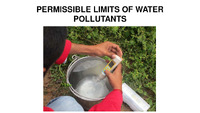 PERMISSIBLE LIMITS OF WATER POLLUTANTS
PERMISSIBLE LIMITS OF WATER POLLUTANTS This presentation contains the permissible of water pollutant.
-
 FICCI - Geospatial Technologies in India - Success Stories
FICCI - Geospatial Technologies in India - Success Stories Geospatial technologies in India have been instrumental in various sectors, including agriculture, mining, infrastructure, transportation, logistics, homeland security, disaster management, defense, and urban planning. These technologies are considered powerful tools that can effectively serve the overall developmental needs of the modern world. As India strives to achieve its developmental goals, the multifaceted and specialized capabilities offered by geospatial technologies will play a crucial role for information management in the future.
Maintaining geospatial technologies for effective decision-making and better governance is one of the mandates of FICCI. This publication is a compilation of Indian case studies of successful applications of this technology, showcasing their immense potential as a tool for planning and management of resources by diverse stakeholders. The publication aims to help in propagating the adoption of this promising technology by various stakeholders from the public and private sector.
The publication also highlights the importance of mapping technologies in preserving access to natural resources and biodiversity, as well as the role of UAVs in social research and the use of LiDAR technology for smart city surveillance.
-
 The rain–runoff response of tropical humid forest ecosystems to use and reforestation in the Western Ghats of India_ Journal of Hydrology
The rain–runoff response of tropical humid forest ecosystems to use and reforestation in the Western Ghats of India_ Journal of Hydrology The study investigates the impact of forest degradation and tree-plantation on degraded or modified forest ecosystems in the Western Ghats of India.
-
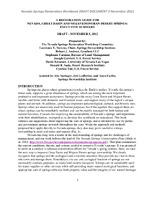 Nevada Springs Restoration Guide
Nevada Springs Restoration Guide Nevada Springs Restoration Workbook is a comprehensive guide for improving the sustainability of Nevada's springs, which are crucial ecosystems that provide water for ranches, farms, and support unique plants and animals. The book outlines suggestions for improving spring care and is intended for public and government springs stewards throughout the state. The approach and methods proposed apply directly to Nevada springs but may also be useful for springs stewardship in most arid states and regions. The Nevada Springs Conservation Plan summarizes the current conditions, threats, and actions needed to conserve Nevada's springs. The handbook suggests a rationale, methods, and approaches for achieving desired conditions and goals for springs management, recognizing the primacy of stewardship rights and goals. The approach can be used to address issues such as defining desired conditions, identifying the problem, determining its severity, solving it, and maintaining the desired condition. If broadly adopted, this approach will greatly improve the ecological health and integrity of these highly valued resources and our natural heritage in general.
-
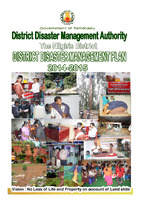 Nilgiris District Disaster Management Plan
Nilgiris District Disaster Management Plan The District Disaster Management Plan 2014-2015 outlines the socio-economic profile, geographical location, area and population, climate and rainfall, irrigation, and past disasters in the Nilgiris District. The plan includes a multihazard disaster management plan, a Hazard, Vulnerability, Capacity and Risk Assessment (HVCRA), and a comprehensive plan for prevention and mitigation measures. The plan includes the roles and actions of various departments, such as the Revenue Department, Police Department, Fire and Rescue Services Department, Rural Development Department, Public Works Department, Highways Department, Civil Supplies Department, Agriculture Department, Medical and Public Health Department, Animal Husbandry Department, Transport Department, Education Department, NCC, NRC & Home Guards, and Defence Personnel. The plan also includes a list of safe shelters, inventory and stock, fire stations, voluntary organizations, medical teams, community kitchens, bakeries, relief and rescue materials, and other essential resources. The plan also includes a list of emergency services, such as emergency medical teams, fire stations, and emergency services, and a list of community halls and bakeries. The plan also includes a list of relief and rescue materials available.
-
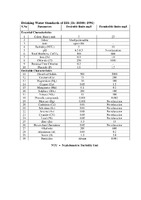 WaterQualityStandards
WaterQualityStandards The Drinking Water Standards of BIS (IS: 10500: 1991) outline the essential characteristics of drinking water, including color, odor, taste, turbidity, pH, total hardness, iron, chloride, residual free chlorine, fluoride, and pesticides. The water's electrical conductivity is also a crucial factor. The upper permissible safe limit for electrical conductivity in water is μmhos/cm at 25 ̊C. The water's quality is evaluated based on Sodium (Na) % Electrical Conductivity μmhos/cm at 25 ̊C. The water's boron concentration is rated based on the class of water, with a rating of excellent <0.25 < 250 < 10 < 1.25, good 20-40 250-750 10-18 1.25-2.0, medium 40-60 750-2250 18-26 2.0-2.5, bad 60-80 2250-4000 >26 2.5-3.0, and very bad >80 >4000 >26 >3.0. The trace elements tolerance for irrigation waters is also outlined. The maximum tolerance limits for industrial effluents discharged (mg/l) are set for color and odor, suspended solids, pH value, dissolved solids, and temperature ̊C. Pesticides are not allowed in the water.
-
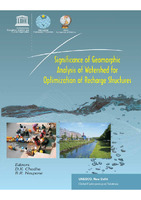 Significance of Geomorphic Analysis of Watershed for Optimization of Recharge Structures
Significance of Geomorphic Analysis of Watershed for Optimization of Recharge Structures he book "Significance of Geomorphic Analysis of Watershed for the Optimization of Recharge Structures" by Dr. D.K. Chadha and Dr. B.R. Neupane, published by UNESCO, aims to integrate geomorphic analysis and stream ordering into the rainwater harvesting initiative. The book presents techniques for optimum utilization of available runoff at different locations within the watershed based on stream ordering and geomorphic analysis of the drainage area. The book is aimed at prompting policy review and research, as well as developing future strategies for implementing measures for water harvesting programs. The book will be useful as a reference manual and guidebook for program managers, students, and field workers working on soil and water conservation or water resources development projects. The continuous increasing demand for water resources, particularly for irrigation, has reached to the point where groundwater development is becoming a major concern.
-
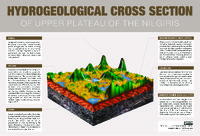 HYDROGEOLOGICAL CROSS SECTION O F U P P E R P L AT E A U O F T H E N I L G I R I S
HYDROGEOLOGICAL CROSS SECTION O F U P P E R P L AT E A U O F T H E N I L G I R I S Wetlands are land areas saturated with water, characterized by aquatic plants adapted to the unique hydric soil. They play various roles in the environment, such as water purification, flood control, carbon sinking, and shoreline stability. Wetlands are the most biologically diverse ecosystems, home to a wide range of plant and animal life. The main types of wetland types include swamps, marshes, bogs, and fens. Springs are locations where water from beneath the ground emerges onto the surface, while streams are bodies of water with surface water flowing within the bed and banks of a channel. Laterite is a soil and rock type rich in iron and aluminum, commonly found in hot and wet tropical areas. Charnockites are metamorphic rocks formed by high-grade regional metamorphic processes, often foliated with alternating darker and lighter colored bands called "gneissic banding."
-
 Optimum Location of Dust Bins Using Geo-Spatial Technology: A Case Study
of Kumbakonam Town, Tamil Nadu, India
Optimum Location of Dust Bins Using Geo-Spatial Technology: A Case Study
of Kumbakonam Town, Tamil Nadu, India Urbanization and changing consumption patterns are leading to an increase in solid waste generation and environmental problems in urban areas. Many cities struggle to manage this due to institutional, regulatory, financial, technical, and public participation shortcomings. The average Indian generates about 490 grams of waste per day. Individual or group awareness and attitudes towards waste generation and management are critical in responding to the waste management challenge. The study focused on household solid waste disposal and optimum location of dust bins using geo-spatial technology. Field data collected with the help of a Global Positioning System survey was transformed into SPSS. The empirical survey included existing location of dust bins and household population with distance from home. Finding alternate locations of dust bins and mapping were also conducted. Municipal solid waste management is a major problem globally, especially in developing-country cities where increased urbanization, poor planning, and lack of adequate resources contribute to poor waste management. In Africa, rapid urban growth since the 1960s has put pressure on land resources, leading to increased waste generation and aggravated by open dumping in slum areas.
-
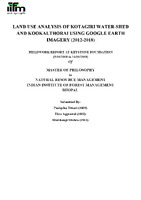 LAND USE ANALYSIS OF KOTAGIRI WATER-SHED AND KOOKALTHORAI USING GOOGLE EARTH IMAGERY (2012-2018)_Field Work report
LAND USE ANALYSIS OF KOTAGIRI WATER-SHED AND KOOKALTHORAI USING GOOGLE EARTH IMAGERY (2012-2018)_Field Work report This study focuses on the land use analysis of Katagiri Watershed and Kookalthorai using Google Earth Imaging (2012-2018) from the Indian Institute of Forest Management in Bhopal. The study aims to understand the changes in land use, including settlements, protected areas, agriculture, and other related categories. Land use mapping helps monitor the changes observed in settlements, agricultural land cover, plantations, and forest cover. The study is based on the findings of the fieldwork report conducted at the Keystone Foundation from 5/10/2018 to 16/10/2018. The study acknowledges the support of Dr. ParulRishi, Dr. Sandeep Tambe, and Dr. C.P. Kala of the Indian Institute of Forest Management, Bhopal, and the Water Monitoring Team. The study also acknowledges the support of the staff members of the Keystone Foundation and their friends for their support throughout the study. The study concludes that land use mapping is a useful tool for understanding land use and its management.
-
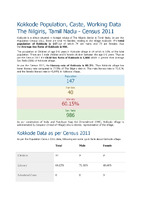 Population Details_Kokode
Population Details_Kokode Kokkode is a village in the Nilgiris district of Tamil Nadu, India, with a population of 147, including 40 families and a child-rearing rate of 1,800. The village has a lower literacy rate of 60.2% compared to the 77.5% of the Nilgiris district. The population is divided into male and female, with a total of 14 children aged 0-6 years. The village is administrated by the Sarpanch, an elected representative of the village. The Census 2011 data shows that 98.1% of the workers are engaged in main work, while 1.9% are involved in marginal activities providing livelihood for less than six months.
-
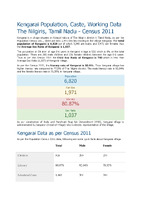 Population Details_Kengarai
Population Details_Kengarai Kengarai is a village in the Nilgiris district of Tamil Nadu, India, with a population of 6,820, with 1,971 families and an average sex ratio of 1,037. The village has a high literacy rate of 80.9%, with male literacy at 92.04% and female literacy at 70.35%. The population is divided into Scheduled Caste (SC) and Scheduled Tribe (ST), with 21.1% of the population belonging to SC and 11.7% to ST. Out of the total population, 4,093 are engaged in work activities, with 92.1% describing their work as Main Work and 7.9% as Marginal. The village is primarily inhabited by cultivators and agricultural laborers.
-
 Population Details_Denad
Population Details_Denad Denad is a village in the Nilgiris district of Tamil Nadu, India, with a population of 8,284 people, with 2,309 families and an average sex ratio of 1,040. The village has a high literacy rate of 83.4%, with male literacy at 91.69% and female literacy at 75.38%. The population is divided into Scheduled Caste (SC) and Scheduled Tribe (ST), with SC constituting 46.1% and ST at 5.5% respectively. Out of the total population, 4,999 are engaged in work activities, with 87.2% describing their work as Main Work and 12.8% as Marginal. The village is primarily inhabited by cultivators and agricultural laborers.
-
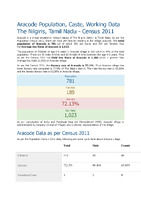 Population Details_Aracode
Population Details_Aracode Aracode is a village in the Nilgiris district of Tamil Nadu, with a population of 781, including 189 families and a child-rearing rate of 1,200. The village has a literacy rate of 72.1%, lower than the 77.5% of the Nilgiris district. The population is divided into Scheduled Caste (SC) and Scheduled Tribe (ST), with a total of 2,209 people. Out of the total population, 432 are engaged in work activities, with 84.3% describing their work as Main Work and 15.7% as Marginal. The village is administrated by a Sarpanch, elected representative of the village.
-
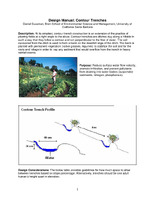 Contour Trenches_Design Manual
Contour Trenches_Design Manual Contour trenches are ditches dug along a hillside to follow a contour and run perpendicular to water flow. The soil excavated from the ditch is used to form a berm on the downhill edge of the ditch, which is planted with permanent vegetation to stabilize the soil and trap sediment. The purpose of contour trench construction is to reduce surface water flow velocity, promote infiltration, and prevent pollutants from draining into water bodies. To construct a properly functioning contour trench, it is important to accurately follow the hill's contour. A low-cost method to determine the contour is to build an A-frame level, which is marked with stakes for excavation. Contour lines are imaginary lines across a slope that are the same height at all places along the slope. To measure contour lines, an A-frame level can be made at no cost and used by one farmer. In areas with heavy storms, it may be dangerous to prevent water completely from flowing down a slope.
-
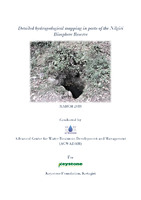 Hydrogeological assessment in select regions of Nilgiris
Hydrogeological assessment in select regions of Nilgiris The Advanced Center for Water Resources Development and Management (ACWADAM) conducted a detailed hydrogeological mapping in parts of the Nilgiri Biosphere Reserve (NBR) in March 2018. The foundation, based in Kotagiri, is working with indigenous communities to improve their lives and livelihoods through eco-development, focusing on water and sanitation. Over 150 water sources have been inventoried by the team, and they have trained local village members to measure rainfall, monitor spring discharge, and measure water levels in open wells. In select villages, the foundation is developing water security plans for better water management and conservation. Data from 59 groundwater sources, including springs, open wells, and bore wells, reveals that 21 springs are still in their pristine condition, but reduced flows have been reported in recent years. The location and ownership of springs pose challenges in conservation and management of spring water.
-
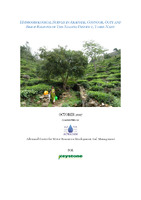 Hydrogeological mapping in selective regions of Nilgiris
Hydrogeological mapping in selective regions of Nilgiris The Advanced Center for Water Resources Development And Management (ACWADAM) conducted a hydrogeological survey in the Aracode, Coonoor, Ooty, and Sigur regions of the Nilgiri district, Tamil Nadu. The district, part of the Western Ghat mountain range, comprises six blocks with rolling topography and elevations greater than 2000 meters above msl. Keystone Foundation in Kotagiri has been working with tribal communities in the Nilgiri district on water resource management. The survey aimed to develop a broad geological understanding of these locations and understand the complexity of groundwater dynamics. The report compiles field observations pertaining to geology and hydrogeology and integrates static and long-term dynamic groundwater data collected from various springs and wells. Based on these observations and field interactions, recharge areas for selective springs were identified, along with recommendations and a possible way forward. The Nilgiri hills fall under the Southern Granulite Terrain of India, characterized by hard, crystalline metamorphic rocks dominated by charnockites and gneisses.
-
 State of the Wetlands
State of the Wetlands On February 12th, the Wetlands and Water Information Centre and a Wetlands park were inaugurated in partnership with Indco Tea Factory in Kattabettu. The Nabard Chairman inaugurated the space, while another wetland in Kotagiri town was about to be converted for a Primary Health Centre. The Rifle Range Wetland, also known as Ubbaranni Haada, was once used for grazing buffaloes. However, land use changes and other communities moving in have reduced the grazing areas, resulting in a reduction in buffalo population. Mr. Raju, a member of the Longwood Shola watchdog committee, has been spearheading campaigns for environmental protection and has been engaging local communities to conserve the wetland. The Keystone Foundation has been engaging local communities to conserve the wetland, which provides drinking water to neighboring areas and is the origin of a stream that flows towards Kottacombai and the Catherine Falls River. Despite repeated calls for conserving wetlands and water bodies, decision-makers have turned a deaf ear to the people's pleas.
-
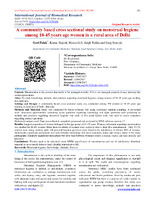 A community based cross sectional study on menstrual hygiene
A community based cross sectional study on menstrual hygiene The study found that education on menstrual hygiene management is crucial for improving women's health and practices, with a significant association between knowledge, socio-economic status, and literacy.
-
 Assessment of menstrual hygiene practices among adolescent girls
Assessment of menstrual hygiene practices among adolescent girls The study found that 72.67% of adolescent girls in rural India are aware of menstruation, 57.33% view it as a physiological process, 85.33% use sanitary pads, and 63.33% practice proper genital cleaning.
-
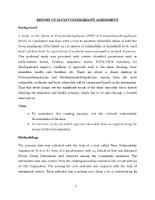 REPORT ON SLUM VULNERABILITY ASSESSMENT
REPORT ON SLUM VULNERABILITY ASSESSMENT Assessed vulnerability of 11 slums in Coimbatore, focusing on sanitation, health services, and socioeconomic status issues, using questionnaires and high alcoholism rates.
-
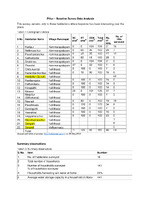 Pillur_Baseline report
Pillur_Baseline report The "Pillur Baseline Report" presents findings from a survey conducted in various habitations regarding sanitation, water supply, and waste management. It highlights the prevalence of open defecation, with 98% of households practicing it, and notes that community toilets are largely unused. The report indicates that only a small percentage of households have access to toilets, with most relying on open defecation. Additionally, it details water supply issues, revealing that many households face challenges in accessing clean water, with some sources contaminated. Waste management practices are also inadequate, as many households do not have proper waste disposal systems. Overall, the report underscores significant public health concerns related to sanitation and water quality in the surveyed areas.
-
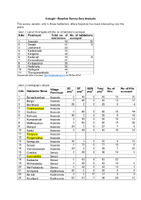 Kotagiri - Baseline Survey Data Analysis
Kotagiri - Baseline Survey Data Analysis The "Kotagiri Baseline Report" presents findings from a survey conducted by the Keystone Foundation, focusing on sanitation and water supply in various habitations. It reveals that out of 323 households surveyed, 46% have household toilets, with a significant portion lacking water supply, leading to open defecation practices in 54% of households. The report highlights the presence and usage of community toilets in only a few areas, while waste management practices are largely inadequate, with no habitations reporting doorstep waste collection. Water supply is primarily sourced from springs and streams, with issues of water quality noted in some areas. Overall, the report underscores critical challenges in sanitation, waste management, and water supply that affect the health and well-being of the communities surveyed.
 Spring Hydrogeology_ Training Manual Springs are a vital source of water supply to villages in the Himalaya, with about 60% of the population relying on natural spring water for drinking water, sanitation, and irrigation. With changing climatic conditions and rainfall patterns, many villages, hamlets, and settlements are facing potential drinking water shortages. Hydrogeological investigations are crucial to address this crisis and the impending peril. The revival of springs is essential for the region's sustainable growth. Over the last few years, many governmental and non-governmental organizations have initiated spring development programs in the Himalayan states. However, many of these programs fail due to lack of knowledge of the subsurface and lack of hydrogeological input in planning recharge measures. Springs are controlled by diverse geological features, which are not targeted by conventional watershed development projects. Recharge plans for springs must address quality issues, which cannot be done without understanding the geological influence on the water. The recharge area of a spring is decided after considering factors such as geology, permeability, weather, spring discharge measurement, and water quality monitoring.
Spring Hydrogeology_ Training Manual Springs are a vital source of water supply to villages in the Himalaya, with about 60% of the population relying on natural spring water for drinking water, sanitation, and irrigation. With changing climatic conditions and rainfall patterns, many villages, hamlets, and settlements are facing potential drinking water shortages. Hydrogeological investigations are crucial to address this crisis and the impending peril. The revival of springs is essential for the region's sustainable growth. Over the last few years, many governmental and non-governmental organizations have initiated spring development programs in the Himalayan states. However, many of these programs fail due to lack of knowledge of the subsurface and lack of hydrogeological input in planning recharge measures. Springs are controlled by diverse geological features, which are not targeted by conventional watershed development projects. Recharge plans for springs must address quality issues, which cannot be done without understanding the geological influence on the water. The recharge area of a spring is decided after considering factors such as geology, permeability, weather, spring discharge measurement, and water quality monitoring. Importance of ground water in The Nilgiri district Groundwater is a vital resource that feeds various sources, including aquifers and springs. Aquifers are rocks or rock material that allow groundwater to store and move within it, making it available to wells, springs, and bore wells. Springs are locations or points on the ground surface where water from beneath the ground emerges on to the surface. Spring depletion can be caused by factors such as climate, land-cover, land-use, and seismicity. Understanding hydrogeology is the first step towards spring management, as it helps identify recharge areas and determine the discharge patterns in these rocks. Spring hydrographs are used to measure precipitation, reduced water levels, and cumulative rainfall. Water quality is also a crucial aspect of groundwater management. Socio-hydrogeology and springshed management are essential for maintaining water quality and preventing groundwater depletion. The Advanced Center for Water Resources Development And Management (ACWADAM) provides information on groundwater sanitation, socio-hydrogeology, and springshed management.
Importance of ground water in The Nilgiri district Groundwater is a vital resource that feeds various sources, including aquifers and springs. Aquifers are rocks or rock material that allow groundwater to store and move within it, making it available to wells, springs, and bore wells. Springs are locations or points on the ground surface where water from beneath the ground emerges on to the surface. Spring depletion can be caused by factors such as climate, land-cover, land-use, and seismicity. Understanding hydrogeology is the first step towards spring management, as it helps identify recharge areas and determine the discharge patterns in these rocks. Spring hydrographs are used to measure precipitation, reduced water levels, and cumulative rainfall. Water quality is also a crucial aspect of groundwater management. Socio-hydrogeology and springshed management are essential for maintaining water quality and preventing groundwater depletion. The Advanced Center for Water Resources Development And Management (ACWADAM) provides information on groundwater sanitation, socio-hydrogeology, and springshed management. PERMISSIBLE LIMITS OF WATER POLLUTANTS This presentation contains the permissible of water pollutant.
PERMISSIBLE LIMITS OF WATER POLLUTANTS This presentation contains the permissible of water pollutant. FICCI - Geospatial Technologies in India - Success Stories Geospatial technologies in India have been instrumental in various sectors, including agriculture, mining, infrastructure, transportation, logistics, homeland security, disaster management, defense, and urban planning. These technologies are considered powerful tools that can effectively serve the overall developmental needs of the modern world. As India strives to achieve its developmental goals, the multifaceted and specialized capabilities offered by geospatial technologies will play a crucial role for information management in the future. Maintaining geospatial technologies for effective decision-making and better governance is one of the mandates of FICCI. This publication is a compilation of Indian case studies of successful applications of this technology, showcasing their immense potential as a tool for planning and management of resources by diverse stakeholders. The publication aims to help in propagating the adoption of this promising technology by various stakeholders from the public and private sector. The publication also highlights the importance of mapping technologies in preserving access to natural resources and biodiversity, as well as the role of UAVs in social research and the use of LiDAR technology for smart city surveillance.
FICCI - Geospatial Technologies in India - Success Stories Geospatial technologies in India have been instrumental in various sectors, including agriculture, mining, infrastructure, transportation, logistics, homeland security, disaster management, defense, and urban planning. These technologies are considered powerful tools that can effectively serve the overall developmental needs of the modern world. As India strives to achieve its developmental goals, the multifaceted and specialized capabilities offered by geospatial technologies will play a crucial role for information management in the future. Maintaining geospatial technologies for effective decision-making and better governance is one of the mandates of FICCI. This publication is a compilation of Indian case studies of successful applications of this technology, showcasing their immense potential as a tool for planning and management of resources by diverse stakeholders. The publication aims to help in propagating the adoption of this promising technology by various stakeholders from the public and private sector. The publication also highlights the importance of mapping technologies in preserving access to natural resources and biodiversity, as well as the role of UAVs in social research and the use of LiDAR technology for smart city surveillance. The rain–runoff response of tropical humid forest ecosystems to use and reforestation in the Western Ghats of India_ Journal of Hydrology The study investigates the impact of forest degradation and tree-plantation on degraded or modified forest ecosystems in the Western Ghats of India.
The rain–runoff response of tropical humid forest ecosystems to use and reforestation in the Western Ghats of India_ Journal of Hydrology The study investigates the impact of forest degradation and tree-plantation on degraded or modified forest ecosystems in the Western Ghats of India. Nevada Springs Restoration Guide Nevada Springs Restoration Workbook is a comprehensive guide for improving the sustainability of Nevada's springs, which are crucial ecosystems that provide water for ranches, farms, and support unique plants and animals. The book outlines suggestions for improving spring care and is intended for public and government springs stewards throughout the state. The approach and methods proposed apply directly to Nevada springs but may also be useful for springs stewardship in most arid states and regions. The Nevada Springs Conservation Plan summarizes the current conditions, threats, and actions needed to conserve Nevada's springs. The handbook suggests a rationale, methods, and approaches for achieving desired conditions and goals for springs management, recognizing the primacy of stewardship rights and goals. The approach can be used to address issues such as defining desired conditions, identifying the problem, determining its severity, solving it, and maintaining the desired condition. If broadly adopted, this approach will greatly improve the ecological health and integrity of these highly valued resources and our natural heritage in general.
Nevada Springs Restoration Guide Nevada Springs Restoration Workbook is a comprehensive guide for improving the sustainability of Nevada's springs, which are crucial ecosystems that provide water for ranches, farms, and support unique plants and animals. The book outlines suggestions for improving spring care and is intended for public and government springs stewards throughout the state. The approach and methods proposed apply directly to Nevada springs but may also be useful for springs stewardship in most arid states and regions. The Nevada Springs Conservation Plan summarizes the current conditions, threats, and actions needed to conserve Nevada's springs. The handbook suggests a rationale, methods, and approaches for achieving desired conditions and goals for springs management, recognizing the primacy of stewardship rights and goals. The approach can be used to address issues such as defining desired conditions, identifying the problem, determining its severity, solving it, and maintaining the desired condition. If broadly adopted, this approach will greatly improve the ecological health and integrity of these highly valued resources and our natural heritage in general. Nilgiris District Disaster Management Plan The District Disaster Management Plan 2014-2015 outlines the socio-economic profile, geographical location, area and population, climate and rainfall, irrigation, and past disasters in the Nilgiris District. The plan includes a multihazard disaster management plan, a Hazard, Vulnerability, Capacity and Risk Assessment (HVCRA), and a comprehensive plan for prevention and mitigation measures. The plan includes the roles and actions of various departments, such as the Revenue Department, Police Department, Fire and Rescue Services Department, Rural Development Department, Public Works Department, Highways Department, Civil Supplies Department, Agriculture Department, Medical and Public Health Department, Animal Husbandry Department, Transport Department, Education Department, NCC, NRC & Home Guards, and Defence Personnel. The plan also includes a list of safe shelters, inventory and stock, fire stations, voluntary organizations, medical teams, community kitchens, bakeries, relief and rescue materials, and other essential resources. The plan also includes a list of emergency services, such as emergency medical teams, fire stations, and emergency services, and a list of community halls and bakeries. The plan also includes a list of relief and rescue materials available.
Nilgiris District Disaster Management Plan The District Disaster Management Plan 2014-2015 outlines the socio-economic profile, geographical location, area and population, climate and rainfall, irrigation, and past disasters in the Nilgiris District. The plan includes a multihazard disaster management plan, a Hazard, Vulnerability, Capacity and Risk Assessment (HVCRA), and a comprehensive plan for prevention and mitigation measures. The plan includes the roles and actions of various departments, such as the Revenue Department, Police Department, Fire and Rescue Services Department, Rural Development Department, Public Works Department, Highways Department, Civil Supplies Department, Agriculture Department, Medical and Public Health Department, Animal Husbandry Department, Transport Department, Education Department, NCC, NRC & Home Guards, and Defence Personnel. The plan also includes a list of safe shelters, inventory and stock, fire stations, voluntary organizations, medical teams, community kitchens, bakeries, relief and rescue materials, and other essential resources. The plan also includes a list of emergency services, such as emergency medical teams, fire stations, and emergency services, and a list of community halls and bakeries. The plan also includes a list of relief and rescue materials available. WaterQualityStandards The Drinking Water Standards of BIS (IS: 10500: 1991) outline the essential characteristics of drinking water, including color, odor, taste, turbidity, pH, total hardness, iron, chloride, residual free chlorine, fluoride, and pesticides. The water's electrical conductivity is also a crucial factor. The upper permissible safe limit for electrical conductivity in water is μmhos/cm at 25 ̊C. The water's quality is evaluated based on Sodium (Na) % Electrical Conductivity μmhos/cm at 25 ̊C. The water's boron concentration is rated based on the class of water, with a rating of excellent <0.25 < 250 < 10 < 1.25, good 20-40 250-750 10-18 1.25-2.0, medium 40-60 750-2250 18-26 2.0-2.5, bad 60-80 2250-4000 >26 2.5-3.0, and very bad >80 >4000 >26 >3.0. The trace elements tolerance for irrigation waters is also outlined. The maximum tolerance limits for industrial effluents discharged (mg/l) are set for color and odor, suspended solids, pH value, dissolved solids, and temperature ̊C. Pesticides are not allowed in the water.
WaterQualityStandards The Drinking Water Standards of BIS (IS: 10500: 1991) outline the essential characteristics of drinking water, including color, odor, taste, turbidity, pH, total hardness, iron, chloride, residual free chlorine, fluoride, and pesticides. The water's electrical conductivity is also a crucial factor. The upper permissible safe limit for electrical conductivity in water is μmhos/cm at 25 ̊C. The water's quality is evaluated based on Sodium (Na) % Electrical Conductivity μmhos/cm at 25 ̊C. The water's boron concentration is rated based on the class of water, with a rating of excellent <0.25 < 250 < 10 < 1.25, good 20-40 250-750 10-18 1.25-2.0, medium 40-60 750-2250 18-26 2.0-2.5, bad 60-80 2250-4000 >26 2.5-3.0, and very bad >80 >4000 >26 >3.0. The trace elements tolerance for irrigation waters is also outlined. The maximum tolerance limits for industrial effluents discharged (mg/l) are set for color and odor, suspended solids, pH value, dissolved solids, and temperature ̊C. Pesticides are not allowed in the water. Significance of Geomorphic Analysis of Watershed for Optimization of Recharge Structures he book "Significance of Geomorphic Analysis of Watershed for the Optimization of Recharge Structures" by Dr. D.K. Chadha and Dr. B.R. Neupane, published by UNESCO, aims to integrate geomorphic analysis and stream ordering into the rainwater harvesting initiative. The book presents techniques for optimum utilization of available runoff at different locations within the watershed based on stream ordering and geomorphic analysis of the drainage area. The book is aimed at prompting policy review and research, as well as developing future strategies for implementing measures for water harvesting programs. The book will be useful as a reference manual and guidebook for program managers, students, and field workers working on soil and water conservation or water resources development projects. The continuous increasing demand for water resources, particularly for irrigation, has reached to the point where groundwater development is becoming a major concern.
Significance of Geomorphic Analysis of Watershed for Optimization of Recharge Structures he book "Significance of Geomorphic Analysis of Watershed for the Optimization of Recharge Structures" by Dr. D.K. Chadha and Dr. B.R. Neupane, published by UNESCO, aims to integrate geomorphic analysis and stream ordering into the rainwater harvesting initiative. The book presents techniques for optimum utilization of available runoff at different locations within the watershed based on stream ordering and geomorphic analysis of the drainage area. The book is aimed at prompting policy review and research, as well as developing future strategies for implementing measures for water harvesting programs. The book will be useful as a reference manual and guidebook for program managers, students, and field workers working on soil and water conservation or water resources development projects. The continuous increasing demand for water resources, particularly for irrigation, has reached to the point where groundwater development is becoming a major concern. HYDROGEOLOGICAL CROSS SECTION O F U P P E R P L AT E A U O F T H E N I L G I R I S Wetlands are land areas saturated with water, characterized by aquatic plants adapted to the unique hydric soil. They play various roles in the environment, such as water purification, flood control, carbon sinking, and shoreline stability. Wetlands are the most biologically diverse ecosystems, home to a wide range of plant and animal life. The main types of wetland types include swamps, marshes, bogs, and fens. Springs are locations where water from beneath the ground emerges onto the surface, while streams are bodies of water with surface water flowing within the bed and banks of a channel. Laterite is a soil and rock type rich in iron and aluminum, commonly found in hot and wet tropical areas. Charnockites are metamorphic rocks formed by high-grade regional metamorphic processes, often foliated with alternating darker and lighter colored bands called "gneissic banding."
HYDROGEOLOGICAL CROSS SECTION O F U P P E R P L AT E A U O F T H E N I L G I R I S Wetlands are land areas saturated with water, characterized by aquatic plants adapted to the unique hydric soil. They play various roles in the environment, such as water purification, flood control, carbon sinking, and shoreline stability. Wetlands are the most biologically diverse ecosystems, home to a wide range of plant and animal life. The main types of wetland types include swamps, marshes, bogs, and fens. Springs are locations where water from beneath the ground emerges onto the surface, while streams are bodies of water with surface water flowing within the bed and banks of a channel. Laterite is a soil and rock type rich in iron and aluminum, commonly found in hot and wet tropical areas. Charnockites are metamorphic rocks formed by high-grade regional metamorphic processes, often foliated with alternating darker and lighter colored bands called "gneissic banding." Optimum Location of Dust Bins Using Geo-Spatial Technology: A Case Study
of Kumbakonam Town, Tamil Nadu, India Urbanization and changing consumption patterns are leading to an increase in solid waste generation and environmental problems in urban areas. Many cities struggle to manage this due to institutional, regulatory, financial, technical, and public participation shortcomings. The average Indian generates about 490 grams of waste per day. Individual or group awareness and attitudes towards waste generation and management are critical in responding to the waste management challenge. The study focused on household solid waste disposal and optimum location of dust bins using geo-spatial technology. Field data collected with the help of a Global Positioning System survey was transformed into SPSS. The empirical survey included existing location of dust bins and household population with distance from home. Finding alternate locations of dust bins and mapping were also conducted. Municipal solid waste management is a major problem globally, especially in developing-country cities where increased urbanization, poor planning, and lack of adequate resources contribute to poor waste management. In Africa, rapid urban growth since the 1960s has put pressure on land resources, leading to increased waste generation and aggravated by open dumping in slum areas.
Optimum Location of Dust Bins Using Geo-Spatial Technology: A Case Study
of Kumbakonam Town, Tamil Nadu, India Urbanization and changing consumption patterns are leading to an increase in solid waste generation and environmental problems in urban areas. Many cities struggle to manage this due to institutional, regulatory, financial, technical, and public participation shortcomings. The average Indian generates about 490 grams of waste per day. Individual or group awareness and attitudes towards waste generation and management are critical in responding to the waste management challenge. The study focused on household solid waste disposal and optimum location of dust bins using geo-spatial technology. Field data collected with the help of a Global Positioning System survey was transformed into SPSS. The empirical survey included existing location of dust bins and household population with distance from home. Finding alternate locations of dust bins and mapping were also conducted. Municipal solid waste management is a major problem globally, especially in developing-country cities where increased urbanization, poor planning, and lack of adequate resources contribute to poor waste management. In Africa, rapid urban growth since the 1960s has put pressure on land resources, leading to increased waste generation and aggravated by open dumping in slum areas. LAND USE ANALYSIS OF KOTAGIRI WATER-SHED AND KOOKALTHORAI USING GOOGLE EARTH IMAGERY (2012-2018)_Field Work report This study focuses on the land use analysis of Katagiri Watershed and Kookalthorai using Google Earth Imaging (2012-2018) from the Indian Institute of Forest Management in Bhopal. The study aims to understand the changes in land use, including settlements, protected areas, agriculture, and other related categories. Land use mapping helps monitor the changes observed in settlements, agricultural land cover, plantations, and forest cover. The study is based on the findings of the fieldwork report conducted at the Keystone Foundation from 5/10/2018 to 16/10/2018. The study acknowledges the support of Dr. ParulRishi, Dr. Sandeep Tambe, and Dr. C.P. Kala of the Indian Institute of Forest Management, Bhopal, and the Water Monitoring Team. The study also acknowledges the support of the staff members of the Keystone Foundation and their friends for their support throughout the study. The study concludes that land use mapping is a useful tool for understanding land use and its management.
LAND USE ANALYSIS OF KOTAGIRI WATER-SHED AND KOOKALTHORAI USING GOOGLE EARTH IMAGERY (2012-2018)_Field Work report This study focuses on the land use analysis of Katagiri Watershed and Kookalthorai using Google Earth Imaging (2012-2018) from the Indian Institute of Forest Management in Bhopal. The study aims to understand the changes in land use, including settlements, protected areas, agriculture, and other related categories. Land use mapping helps monitor the changes observed in settlements, agricultural land cover, plantations, and forest cover. The study is based on the findings of the fieldwork report conducted at the Keystone Foundation from 5/10/2018 to 16/10/2018. The study acknowledges the support of Dr. ParulRishi, Dr. Sandeep Tambe, and Dr. C.P. Kala of the Indian Institute of Forest Management, Bhopal, and the Water Monitoring Team. The study also acknowledges the support of the staff members of the Keystone Foundation and their friends for their support throughout the study. The study concludes that land use mapping is a useful tool for understanding land use and its management. Population Details_Kokode Kokkode is a village in the Nilgiris district of Tamil Nadu, India, with a population of 147, including 40 families and a child-rearing rate of 1,800. The village has a lower literacy rate of 60.2% compared to the 77.5% of the Nilgiris district. The population is divided into male and female, with a total of 14 children aged 0-6 years. The village is administrated by the Sarpanch, an elected representative of the village. The Census 2011 data shows that 98.1% of the workers are engaged in main work, while 1.9% are involved in marginal activities providing livelihood for less than six months.
Population Details_Kokode Kokkode is a village in the Nilgiris district of Tamil Nadu, India, with a population of 147, including 40 families and a child-rearing rate of 1,800. The village has a lower literacy rate of 60.2% compared to the 77.5% of the Nilgiris district. The population is divided into male and female, with a total of 14 children aged 0-6 years. The village is administrated by the Sarpanch, an elected representative of the village. The Census 2011 data shows that 98.1% of the workers are engaged in main work, while 1.9% are involved in marginal activities providing livelihood for less than six months. Population Details_Kengarai Kengarai is a village in the Nilgiris district of Tamil Nadu, India, with a population of 6,820, with 1,971 families and an average sex ratio of 1,037. The village has a high literacy rate of 80.9%, with male literacy at 92.04% and female literacy at 70.35%. The population is divided into Scheduled Caste (SC) and Scheduled Tribe (ST), with 21.1% of the population belonging to SC and 11.7% to ST. Out of the total population, 4,093 are engaged in work activities, with 92.1% describing their work as Main Work and 7.9% as Marginal. The village is primarily inhabited by cultivators and agricultural laborers.
Population Details_Kengarai Kengarai is a village in the Nilgiris district of Tamil Nadu, India, with a population of 6,820, with 1,971 families and an average sex ratio of 1,037. The village has a high literacy rate of 80.9%, with male literacy at 92.04% and female literacy at 70.35%. The population is divided into Scheduled Caste (SC) and Scheduled Tribe (ST), with 21.1% of the population belonging to SC and 11.7% to ST. Out of the total population, 4,093 are engaged in work activities, with 92.1% describing their work as Main Work and 7.9% as Marginal. The village is primarily inhabited by cultivators and agricultural laborers. Population Details_Denad Denad is a village in the Nilgiris district of Tamil Nadu, India, with a population of 8,284 people, with 2,309 families and an average sex ratio of 1,040. The village has a high literacy rate of 83.4%, with male literacy at 91.69% and female literacy at 75.38%. The population is divided into Scheduled Caste (SC) and Scheduled Tribe (ST), with SC constituting 46.1% and ST at 5.5% respectively. Out of the total population, 4,999 are engaged in work activities, with 87.2% describing their work as Main Work and 12.8% as Marginal. The village is primarily inhabited by cultivators and agricultural laborers.
Population Details_Denad Denad is a village in the Nilgiris district of Tamil Nadu, India, with a population of 8,284 people, with 2,309 families and an average sex ratio of 1,040. The village has a high literacy rate of 83.4%, with male literacy at 91.69% and female literacy at 75.38%. The population is divided into Scheduled Caste (SC) and Scheduled Tribe (ST), with SC constituting 46.1% and ST at 5.5% respectively. Out of the total population, 4,999 are engaged in work activities, with 87.2% describing their work as Main Work and 12.8% as Marginal. The village is primarily inhabited by cultivators and agricultural laborers. Population Details_Aracode Aracode is a village in the Nilgiris district of Tamil Nadu, with a population of 781, including 189 families and a child-rearing rate of 1,200. The village has a literacy rate of 72.1%, lower than the 77.5% of the Nilgiris district. The population is divided into Scheduled Caste (SC) and Scheduled Tribe (ST), with a total of 2,209 people. Out of the total population, 432 are engaged in work activities, with 84.3% describing their work as Main Work and 15.7% as Marginal. The village is administrated by a Sarpanch, elected representative of the village.
Population Details_Aracode Aracode is a village in the Nilgiris district of Tamil Nadu, with a population of 781, including 189 families and a child-rearing rate of 1,200. The village has a literacy rate of 72.1%, lower than the 77.5% of the Nilgiris district. The population is divided into Scheduled Caste (SC) and Scheduled Tribe (ST), with a total of 2,209 people. Out of the total population, 432 are engaged in work activities, with 84.3% describing their work as Main Work and 15.7% as Marginal. The village is administrated by a Sarpanch, elected representative of the village. Contour Trenches_Design Manual Contour trenches are ditches dug along a hillside to follow a contour and run perpendicular to water flow. The soil excavated from the ditch is used to form a berm on the downhill edge of the ditch, which is planted with permanent vegetation to stabilize the soil and trap sediment. The purpose of contour trench construction is to reduce surface water flow velocity, promote infiltration, and prevent pollutants from draining into water bodies. To construct a properly functioning contour trench, it is important to accurately follow the hill's contour. A low-cost method to determine the contour is to build an A-frame level, which is marked with stakes for excavation. Contour lines are imaginary lines across a slope that are the same height at all places along the slope. To measure contour lines, an A-frame level can be made at no cost and used by one farmer. In areas with heavy storms, it may be dangerous to prevent water completely from flowing down a slope.
Contour Trenches_Design Manual Contour trenches are ditches dug along a hillside to follow a contour and run perpendicular to water flow. The soil excavated from the ditch is used to form a berm on the downhill edge of the ditch, which is planted with permanent vegetation to stabilize the soil and trap sediment. The purpose of contour trench construction is to reduce surface water flow velocity, promote infiltration, and prevent pollutants from draining into water bodies. To construct a properly functioning contour trench, it is important to accurately follow the hill's contour. A low-cost method to determine the contour is to build an A-frame level, which is marked with stakes for excavation. Contour lines are imaginary lines across a slope that are the same height at all places along the slope. To measure contour lines, an A-frame level can be made at no cost and used by one farmer. In areas with heavy storms, it may be dangerous to prevent water completely from flowing down a slope. Hydrogeological assessment in select regions of Nilgiris The Advanced Center for Water Resources Development and Management (ACWADAM) conducted a detailed hydrogeological mapping in parts of the Nilgiri Biosphere Reserve (NBR) in March 2018. The foundation, based in Kotagiri, is working with indigenous communities to improve their lives and livelihoods through eco-development, focusing on water and sanitation. Over 150 water sources have been inventoried by the team, and they have trained local village members to measure rainfall, monitor spring discharge, and measure water levels in open wells. In select villages, the foundation is developing water security plans for better water management and conservation. Data from 59 groundwater sources, including springs, open wells, and bore wells, reveals that 21 springs are still in their pristine condition, but reduced flows have been reported in recent years. The location and ownership of springs pose challenges in conservation and management of spring water.
Hydrogeological assessment in select regions of Nilgiris The Advanced Center for Water Resources Development and Management (ACWADAM) conducted a detailed hydrogeological mapping in parts of the Nilgiri Biosphere Reserve (NBR) in March 2018. The foundation, based in Kotagiri, is working with indigenous communities to improve their lives and livelihoods through eco-development, focusing on water and sanitation. Over 150 water sources have been inventoried by the team, and they have trained local village members to measure rainfall, monitor spring discharge, and measure water levels in open wells. In select villages, the foundation is developing water security plans for better water management and conservation. Data from 59 groundwater sources, including springs, open wells, and bore wells, reveals that 21 springs are still in their pristine condition, but reduced flows have been reported in recent years. The location and ownership of springs pose challenges in conservation and management of spring water. Hydrogeological mapping in selective regions of Nilgiris The Advanced Center for Water Resources Development And Management (ACWADAM) conducted a hydrogeological survey in the Aracode, Coonoor, Ooty, and Sigur regions of the Nilgiri district, Tamil Nadu. The district, part of the Western Ghat mountain range, comprises six blocks with rolling topography and elevations greater than 2000 meters above msl. Keystone Foundation in Kotagiri has been working with tribal communities in the Nilgiri district on water resource management. The survey aimed to develop a broad geological understanding of these locations and understand the complexity of groundwater dynamics. The report compiles field observations pertaining to geology and hydrogeology and integrates static and long-term dynamic groundwater data collected from various springs and wells. Based on these observations and field interactions, recharge areas for selective springs were identified, along with recommendations and a possible way forward. The Nilgiri hills fall under the Southern Granulite Terrain of India, characterized by hard, crystalline metamorphic rocks dominated by charnockites and gneisses.
Hydrogeological mapping in selective regions of Nilgiris The Advanced Center for Water Resources Development And Management (ACWADAM) conducted a hydrogeological survey in the Aracode, Coonoor, Ooty, and Sigur regions of the Nilgiri district, Tamil Nadu. The district, part of the Western Ghat mountain range, comprises six blocks with rolling topography and elevations greater than 2000 meters above msl. Keystone Foundation in Kotagiri has been working with tribal communities in the Nilgiri district on water resource management. The survey aimed to develop a broad geological understanding of these locations and understand the complexity of groundwater dynamics. The report compiles field observations pertaining to geology and hydrogeology and integrates static and long-term dynamic groundwater data collected from various springs and wells. Based on these observations and field interactions, recharge areas for selective springs were identified, along with recommendations and a possible way forward. The Nilgiri hills fall under the Southern Granulite Terrain of India, characterized by hard, crystalline metamorphic rocks dominated by charnockites and gneisses. State of the Wetlands On February 12th, the Wetlands and Water Information Centre and a Wetlands park were inaugurated in partnership with Indco Tea Factory in Kattabettu. The Nabard Chairman inaugurated the space, while another wetland in Kotagiri town was about to be converted for a Primary Health Centre. The Rifle Range Wetland, also known as Ubbaranni Haada, was once used for grazing buffaloes. However, land use changes and other communities moving in have reduced the grazing areas, resulting in a reduction in buffalo population. Mr. Raju, a member of the Longwood Shola watchdog committee, has been spearheading campaigns for environmental protection and has been engaging local communities to conserve the wetland. The Keystone Foundation has been engaging local communities to conserve the wetland, which provides drinking water to neighboring areas and is the origin of a stream that flows towards Kottacombai and the Catherine Falls River. Despite repeated calls for conserving wetlands and water bodies, decision-makers have turned a deaf ear to the people's pleas.
State of the Wetlands On February 12th, the Wetlands and Water Information Centre and a Wetlands park were inaugurated in partnership with Indco Tea Factory in Kattabettu. The Nabard Chairman inaugurated the space, while another wetland in Kotagiri town was about to be converted for a Primary Health Centre. The Rifle Range Wetland, also known as Ubbaranni Haada, was once used for grazing buffaloes. However, land use changes and other communities moving in have reduced the grazing areas, resulting in a reduction in buffalo population. Mr. Raju, a member of the Longwood Shola watchdog committee, has been spearheading campaigns for environmental protection and has been engaging local communities to conserve the wetland. The Keystone Foundation has been engaging local communities to conserve the wetland, which provides drinking water to neighboring areas and is the origin of a stream that flows towards Kottacombai and the Catherine Falls River. Despite repeated calls for conserving wetlands and water bodies, decision-makers have turned a deaf ear to the people's pleas. A community based cross sectional study on menstrual hygiene The study found that education on menstrual hygiene management is crucial for improving women's health and practices, with a significant association between knowledge, socio-economic status, and literacy.
A community based cross sectional study on menstrual hygiene The study found that education on menstrual hygiene management is crucial for improving women's health and practices, with a significant association between knowledge, socio-economic status, and literacy. Assessment of menstrual hygiene practices among adolescent girls The study found that 72.67% of adolescent girls in rural India are aware of menstruation, 57.33% view it as a physiological process, 85.33% use sanitary pads, and 63.33% practice proper genital cleaning.
Assessment of menstrual hygiene practices among adolescent girls The study found that 72.67% of adolescent girls in rural India are aware of menstruation, 57.33% view it as a physiological process, 85.33% use sanitary pads, and 63.33% practice proper genital cleaning. REPORT ON SLUM VULNERABILITY ASSESSMENT Assessed vulnerability of 11 slums in Coimbatore, focusing on sanitation, health services, and socioeconomic status issues, using questionnaires and high alcoholism rates.
REPORT ON SLUM VULNERABILITY ASSESSMENT Assessed vulnerability of 11 slums in Coimbatore, focusing on sanitation, health services, and socioeconomic status issues, using questionnaires and high alcoholism rates. Pillur_Baseline report The "Pillur Baseline Report" presents findings from a survey conducted in various habitations regarding sanitation, water supply, and waste management. It highlights the prevalence of open defecation, with 98% of households practicing it, and notes that community toilets are largely unused. The report indicates that only a small percentage of households have access to toilets, with most relying on open defecation. Additionally, it details water supply issues, revealing that many households face challenges in accessing clean water, with some sources contaminated. Waste management practices are also inadequate, as many households do not have proper waste disposal systems. Overall, the report underscores significant public health concerns related to sanitation and water quality in the surveyed areas.
Pillur_Baseline report The "Pillur Baseline Report" presents findings from a survey conducted in various habitations regarding sanitation, water supply, and waste management. It highlights the prevalence of open defecation, with 98% of households practicing it, and notes that community toilets are largely unused. The report indicates that only a small percentage of households have access to toilets, with most relying on open defecation. Additionally, it details water supply issues, revealing that many households face challenges in accessing clean water, with some sources contaminated. Waste management practices are also inadequate, as many households do not have proper waste disposal systems. Overall, the report underscores significant public health concerns related to sanitation and water quality in the surveyed areas. Kotagiri - Baseline Survey Data Analysis The "Kotagiri Baseline Report" presents findings from a survey conducted by the Keystone Foundation, focusing on sanitation and water supply in various habitations. It reveals that out of 323 households surveyed, 46% have household toilets, with a significant portion lacking water supply, leading to open defecation practices in 54% of households. The report highlights the presence and usage of community toilets in only a few areas, while waste management practices are largely inadequate, with no habitations reporting doorstep waste collection. Water supply is primarily sourced from springs and streams, with issues of water quality noted in some areas. Overall, the report underscores critical challenges in sanitation, waste management, and water supply that affect the health and well-being of the communities surveyed.
Kotagiri - Baseline Survey Data Analysis The "Kotagiri Baseline Report" presents findings from a survey conducted by the Keystone Foundation, focusing on sanitation and water supply in various habitations. It reveals that out of 323 households surveyed, 46% have household toilets, with a significant portion lacking water supply, leading to open defecation practices in 54% of households. The report highlights the presence and usage of community toilets in only a few areas, while waste management practices are largely inadequate, with no habitations reporting doorstep waste collection. Water supply is primarily sourced from springs and streams, with issues of water quality noted in some areas. Overall, the report underscores critical challenges in sanitation, waste management, and water supply that affect the health and well-being of the communities surveyed.